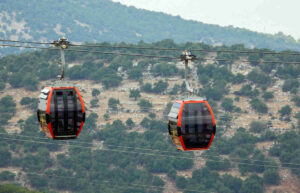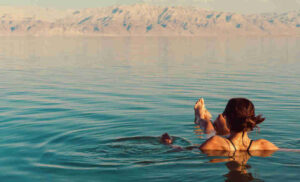The most famous mosaic of Madaba is, without a doubt, the map of the Holy Land that we explained in detail in this other post. However, it is not the only one done by the Romans and Byzantines in this city, far from it: the establishment of the city as an episcopal see led to the construction of numerous churches, and many of those other mosaics of Madaba are precisely linked to these ancient temples, or to residences of high society. Therefore, if you plan to visit this destination calmly, pay attention to the following lines, where we show you those mosaics that account for the great splendor that this city reached in the first centuries of our era.
Mosaics of the Archaeological Park I
The first place you can admire those other Madaba mosaics is the Archaeological Park I, very close to the visitor center. Although here are the ruins of the church of the Virgin Mary, which has magnificent pavements decorated with this technique, perhaps the most famous mosaic is that of the myth of Hippolytus (sixth century), located in the homonymous hall and magnificently preserved. For this reason, you can see the nice scene in which Aphrodite whips her son, Eros, with a sandal. In addition, at the entrance to the enclosure are exhibited the battered remains of a mosaic located a few kilometers from Madaba, in Maqueronte: despite their condition, their importance lies in their antiquity, as they date from the first century BC and are, therefore, the oldest in the country.
Mosaics of the Archaeological Park II
Across Al-Amir Hasan Street is the city’s second archaeological park. Here, the protagonist is the remains of a luxurious mansion that, as it could not be otherwise, was decorated with rich mosaics. In this case, with a hunting theme, which serves to admire the naturalistic representation of fauna and flora. The remains of the church of the Martyrs are also located here, with pavement decorated in a very similar style.
Mosaics of the Madaba Museum
Madaba has a museum where you can see mosaics and other archaeological pieces in a more relaxed and contextualized environment. In addition, it allows the exhibition of more casual themes. For this reason, some mosaics that cause great interest are exhibited here in all their splendour: those of Ariadne at a sensual dance and a Bacchic procession, with a naked satyr. The mosaics of Paradise or those of the Twal Family Chapel also reach high levels of quality, with naturalistic designs of roosters, deer, lions and bulls, among others. The collection is completed by other more generic archaeological pieces to explain the history of Madaba.
Mosaics of the Church of the Apostles
On this route through the other mosaics of Madaba you should not miss those exhibited in the Church of the Apostles, which no longer functions as a religious temple. They were made in the sixth century and rediscovered in the twentieth century by an Italian parish priest. In the central nave, like a majestic carpet, a large mosaic is spread across the floor, with birds and acanthus leaves, among other details of the decoration. Of unusual beauty isthe central medallion of about 2.2 meters wide, where you can contemplate the personification of the Sea, emerging from the waters. Around him, colorful fish, a jellyfish, a sea monster and what appear to be two sharks. As a curiosity, this medallion was restored, extracted and moved to a new support, which was taken to the Jordan pavilion during the Universal Exhibition of Seville 92, as it is an unbeatable example of the quality of Jordanian mosaics.



